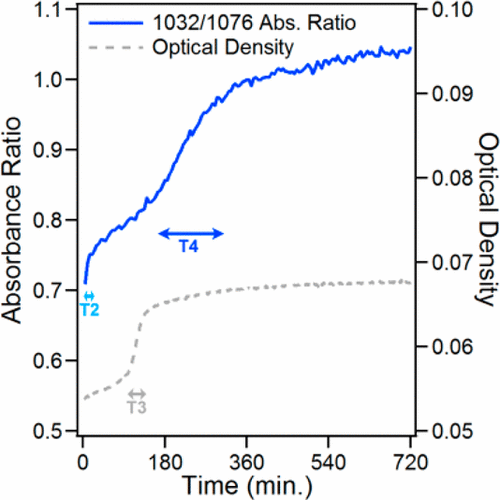当前位置:
X-MOL 学术
›
Biomacromolecules
›
论文详情
Our official English website, www.x-mol.net, welcomes your feedback! (Note: you will need to create a separate account there.)
Polyaspartic Acid Concentration Controls the Rate of Calcium Phosphate Nanorod Formation in High Concentration Systems
Biomacromolecules ( IF 6.2 ) Pub Date : 2017-09-05 00:00:00 , DOI: 10.1021/acs.biomac.7b00772 Daniel V. Krogstad 1 , Dongbo Wang 1 , Sheng Lin-Gibson 1
Biomacromolecules ( IF 6.2 ) Pub Date : 2017-09-05 00:00:00 , DOI: 10.1021/acs.biomac.7b00772 Daniel V. Krogstad 1 , Dongbo Wang 1 , Sheng Lin-Gibson 1
Affiliation

|
Polyelectrolytes are known to greatly affect calcium phosphate (CaP) mineralization. The reaction kinetics as well as the CaP phase, morphology and aggregation state depend on the relative concentrations of the polyelectrolyte and the inorganic ions in a complex, nonlinear manner. This study examines the structural evolution and kinetics of polyaspartic acid (pAsp) directed CaP mineralization at high concentrations of polyelectrolytes, calcium, and total phosphate (19–30 mg/mL pAsp, 50–100 mM Ca2+, Ca/P = 2). Using a novel combination of characterization techniques including cryogenic transmission electron microscopy (cryo-TEM), spectrophotometry, X-ray total scattering pair distribution function analysis, and attenuated total reflectance Fourier transform infrared spectroscopy (ATR-FTIR), it was determined that the CaP mineralization occurred over four transition steps. The steps include the formation of aggregates of pAsp stabilized CaP spherical nanoparticles (sNP), crystallization of sNP, oriented attachment of the sNP into nanorods, and further crystallization of the nanorods. The intermediate aggregate sizes and the reaction kinetics were found to be highly polymer concentration dependent while the sizes of the particles were not concentration dependent. This study demonstrates the complex role of pAsp in controlling the mechanism as well as the kinetics of CaP mineralization.
中文翻译:

高浓度系统中聚天冬氨酸的浓度控制着磷酸钙纳米棒的形成速率
已知聚电解质会极大地影响磷酸钙(CaP)的矿化作用。反应动力学以及CaP相,形态和聚集态以复杂的非线性方式取决于聚电解质和无机离子的相对浓度。这项研究研究了在高浓度的聚电解质,钙和总磷酸盐(19–30 mg / mL pAsp,50–100 mM Ca 2+)下,聚天冬氨酸(pAsp)指导的CaP矿化的结构演化和动力学。,Ca / P = 2)。使用低温透射电子显微镜(cryo-TEM),分光光度法,X射线总散射对分布函数分析和衰减全反射傅里叶变换红外光谱(ATR-FTIR)等表征技术的新颖组合,确定了CaP矿化发生在四个过渡步骤上。这些步骤包括形成pAsp稳定的CaP球形纳米颗粒(sNP)的聚集体,sNP的结晶,sNP定向附着到纳米棒中以及纳米棒的进一步结晶。发现中间聚集体尺寸和反应动力学高度依赖于聚合物浓度,而颗粒尺寸不依赖于浓度。
更新日期:2017-09-05
中文翻译:

高浓度系统中聚天冬氨酸的浓度控制着磷酸钙纳米棒的形成速率
已知聚电解质会极大地影响磷酸钙(CaP)的矿化作用。反应动力学以及CaP相,形态和聚集态以复杂的非线性方式取决于聚电解质和无机离子的相对浓度。这项研究研究了在高浓度的聚电解质,钙和总磷酸盐(19–30 mg / mL pAsp,50–100 mM Ca 2+)下,聚天冬氨酸(pAsp)指导的CaP矿化的结构演化和动力学。,Ca / P = 2)。使用低温透射电子显微镜(cryo-TEM),分光光度法,X射线总散射对分布函数分析和衰减全反射傅里叶变换红外光谱(ATR-FTIR)等表征技术的新颖组合,确定了CaP矿化发生在四个过渡步骤上。这些步骤包括形成pAsp稳定的CaP球形纳米颗粒(sNP)的聚集体,sNP的结晶,sNP定向附着到纳米棒中以及纳米棒的进一步结晶。发现中间聚集体尺寸和反应动力学高度依赖于聚合物浓度,而颗粒尺寸不依赖于浓度。



























 京公网安备 11010802027423号
京公网安备 11010802027423号